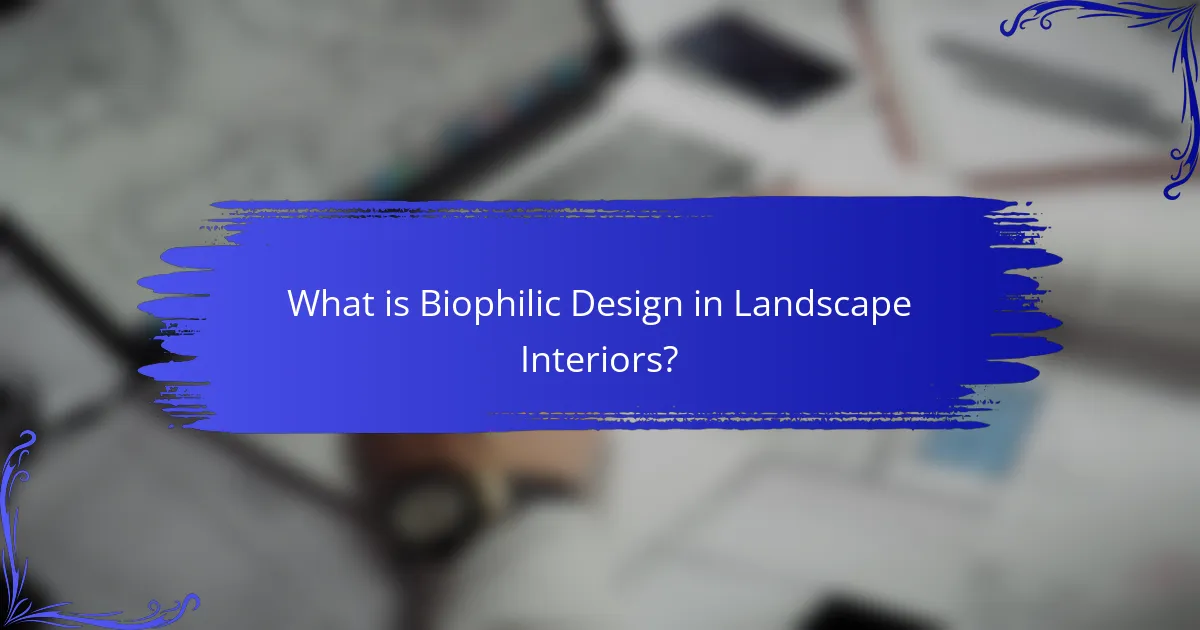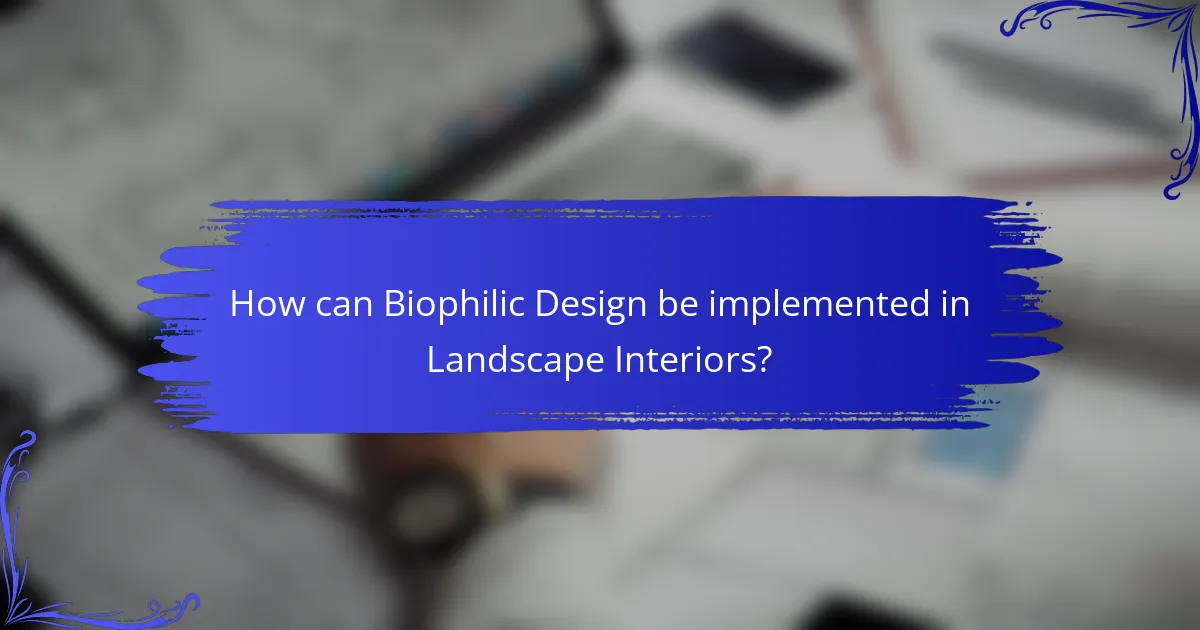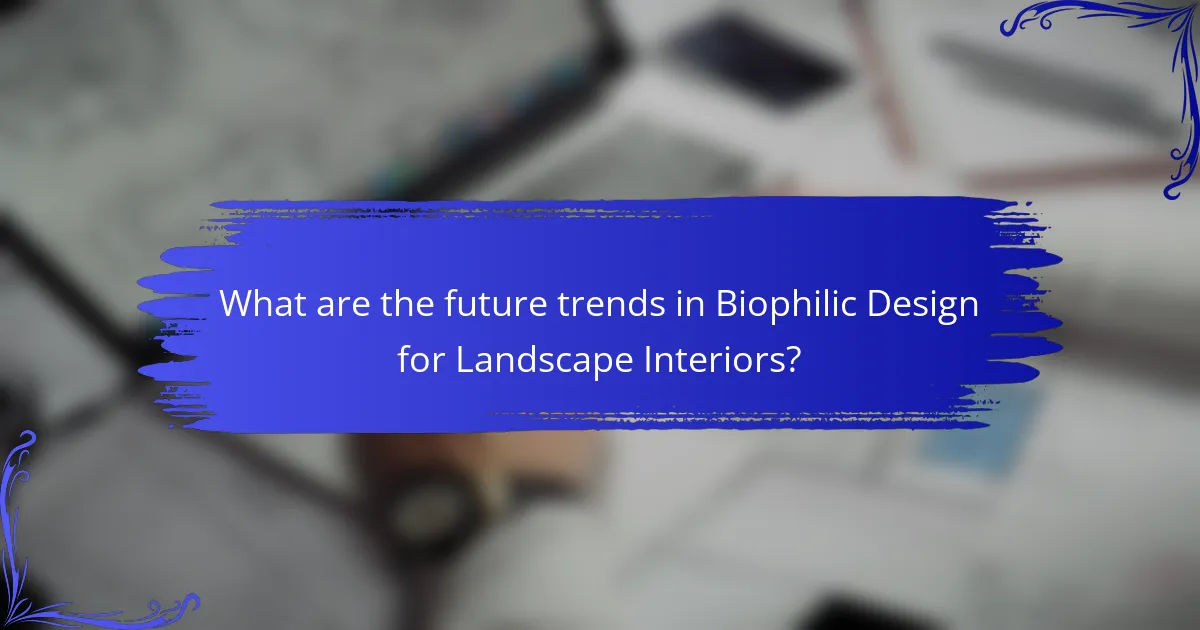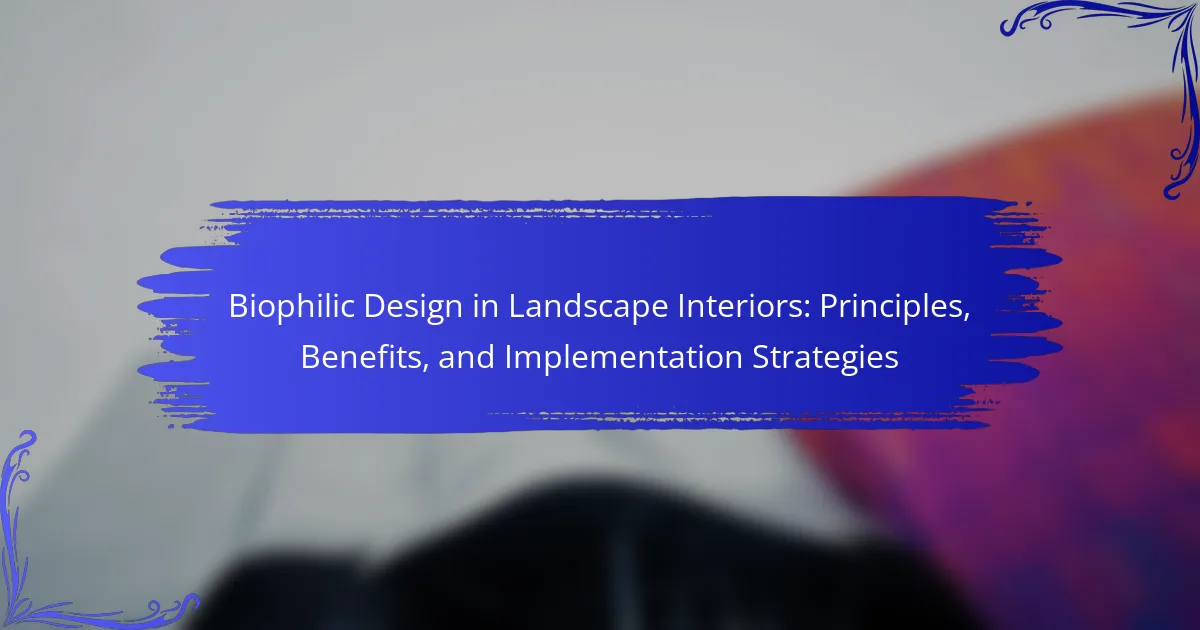Biophilic design in landscape interiors integrates natural elements into indoor spaces to enhance the connection between people and nature. This design philosophy incorporates features such as natural light, plants, water elements, and organic materials, which have been shown to improve well-being, reduce stress, and enhance productivity. Key implementation strategies include maximizing daylight, incorporating greenery and water features, and using sustainable materials. Future trends indicate a growing integration of technology and a focus on mental well-being, reinforcing the importance of biophilic elements in creating healthier indoor environments.

What is Biophilic Design in Landscape Interiors?
Biophilic design in landscape interiors is an approach that integrates natural elements into indoor spaces. This design philosophy aims to enhance the connection between people and nature. It incorporates features such as natural light, plants, water elements, and organic materials. Research indicates that biophilic design can improve well-being and productivity. Studies show that exposure to natural elements reduces stress and enhances mood. The implementation of biophilic design can lead to healthier indoor environments. It is increasingly adopted in architectural practices to create more sustainable and enjoyable spaces.
How does Biophilic Design influence our connection to nature?
Biophilic design enhances our connection to nature by integrating natural elements into built environments. This approach fosters a sense of well-being and tranquility. Incorporating features like natural light, plants, and water elements mimics the experience of being outdoors. Research indicates that exposure to nature reduces stress and improves mood. A study by Kaplan and Kaplan (1989) found that natural environments promote restorative experiences. Biophilic design also encourages social interaction, which can strengthen community ties. Overall, it creates spaces that resonate with our innate affinity for nature.
What are the fundamental principles of Biophilic Design?
The fundamental principles of Biophilic Design include the integration of natural elements into built environments. These principles aim to enhance human well-being and foster a connection to nature. Key aspects involve using natural light, incorporating plant life, and employing natural materials. Additionally, Biophilic Design emphasizes views of nature and the use of water features. Research shows that environments designed with these principles can improve cognitive function and reduce stress. Studies indicate that exposure to natural elements can enhance mood and productivity. Implementing these principles leads to healthier, more sustainable spaces that resonate with human instincts.
How does Biophilic Design differ from traditional design approaches?
Biophilic Design emphasizes a connection to nature, while traditional design often prioritizes functionality and aesthetics. Biophilic Design incorporates natural elements, such as plants and natural light, to enhance well-being. Traditional design may overlook these aspects, focusing on artificial materials and structures. Research indicates that Biophilic Design can improve mental health, productivity, and overall satisfaction in spaces. A study by Kaplan and Kaplan highlights how exposure to nature reduces stress and enhances cognitive function. Thus, Biophilic Design fundamentally differs by integrating nature into the built environment for holistic benefits.
What are the key benefits of Biophilic Design in Landscape Interiors?
Biophilic design in landscape interiors enhances well-being and connection to nature. It promotes mental health by reducing stress and anxiety levels. Studies show that exposure to natural elements improves mood and productivity. Integrating plants and natural materials increases air quality and creates a calming environment. Natural light in interior spaces boosts energy and focus. Additionally, biophilic design fosters creativity and innovation through inspiring surroundings. Research indicates that these environments can lead to higher satisfaction and engagement among occupants.
How does Biophilic Design enhance mental well-being?
Biophilic Design enhances mental well-being by incorporating natural elements into built environments. This design approach promotes a connection to nature, which has been shown to reduce stress and anxiety. Studies indicate that exposure to natural light, plants, and water features can improve mood and cognitive function. For example, a study published in the Journal of Environmental Psychology found that individuals in biophilic environments reported higher levels of well-being. Furthermore, biophilic Design can lead to increased focus and creativity, as natural elements stimulate the mind. Overall, integrating nature into interior spaces fosters a healthier psychological state.
What impact does Biophilic Design have on productivity and creativity?
Biophilic Design significantly enhances productivity and creativity. This design approach incorporates natural elements into built environments. Studies show that workplaces with biophilic features improve employee satisfaction. A research by Kaplan and Kaplan (1989) indicates that exposure to nature reduces stress and increases focus. Additionally, a study published in the Journal of Environmental Psychology found that natural light and greenery boost cognitive function. Employees in biophilic spaces report higher levels of creativity and innovative thinking. Overall, integrating biophilic design leads to improved work performance and creative outcomes.
What are the essential elements of Biophilic Design?
The essential elements of Biophilic Design include natural light, vegetation, and natural materials. Natural light enhances mood and productivity. Incorporating plants improves air quality and reduces stress. Natural materials, such as wood and stone, foster a connection to nature. Water features create calming environments and promote relaxation. Views of nature enhance well-being and cognitive function. Spatial variability encourages movement and exploration. These elements collectively create spaces that support physical and mental health. Research shows that environments designed with these elements can significantly improve occupant satisfaction and performance.
Which natural materials are commonly used in Biophilic Design?
Natural materials commonly used in Biophilic Design include wood, stone, and plants. Wood is utilized for its warmth and connection to nature. It can be found in furniture, flooring, and wall treatments. Stone is valued for its durability and natural aesthetic. It is often used in surfaces and landscaping features. Plants are essential in Biophilic Design, providing greenery and improving air quality. They can be incorporated as indoor plants, green walls, or outdoor landscaping. These materials enhance the connection between indoor spaces and the natural environment. Their use is supported by studies highlighting the psychological benefits of natural elements in design.
How do light and space contribute to Biophilic Design?
Light and space significantly enhance Biophilic Design by creating environments that foster well-being. Natural light improves mood and productivity, as studies show exposure to daylight can increase serotonin levels. Space, when designed thoughtfully, allows for movement and interaction with nature, promoting a sense of connection. Open spaces can reduce stress and enhance cognitive function. Incorporating elements like large windows and skylights maximizes natural light. This design approach aligns with the principles of Biophilic Design, which emphasizes human connection to nature. Research indicates that environments with ample light and space can lead to higher satisfaction and lower anxiety levels among occupants.

How can Biophilic Design be implemented in Landscape Interiors?
Biophilic design can be implemented in landscape interiors by integrating natural elements into the space. This includes using plants, water features, and natural materials. Incorporating greenery can improve air quality and enhance mood. Water features can create soothing sounds and promote relaxation. Natural materials like wood and stone can add texture and warmth. Daylight should be maximized to connect occupants with the outside environment. Views of nature can be framed through windows or openings. Creating diverse habitats within the landscape can support local biodiversity. These strategies align with biophilic principles, fostering a deeper connection between people and nature.
What are the steps for integrating Biophilic Design into a project?
Identify the project goals and objectives related to Biophilic Design. Conduct a site analysis to assess natural elements and existing conditions. Engage stakeholders to gather input on design preferences. Develop design concepts that incorporate natural materials, light, and vegetation. Create a detailed design plan that includes Biophilic elements. Implement the design with a focus on sustainability and ecological balance. Evaluate the project post-implementation to assess the effectiveness of Biophilic Design. Adjust and refine the design based on feedback and performance metrics.
How do you assess a space for Biophilic Design opportunities?
To assess a space for Biophilic Design opportunities, begin by evaluating natural elements present in the environment. Identify existing vegetation, water features, and natural light sources. Observe how these elements interact with the space and the occupants. Assess the spatial layout for opportunities to integrate more natural materials and textures. Consider the potential for views of nature from different vantage points. Analyze the air quality and acoustics to enhance the sensory experience. Research shows that incorporating biophilic elements can improve well-being and productivity by up to 15% (Kaplan & Kaplan, 1989). This evidence supports the importance of integrating nature into design for enhanced user experience.
What design strategies can be employed to enhance Biophilic elements?
Incorporating natural elements is a key design strategy to enhance Biophilic elements. This can include using plants, natural materials, and water features. Integrating daylight through large windows or skylights also promotes a connection with nature. Creating views of landscapes or green spaces from interior spaces enhances this connection further. Employing organic shapes and patterns in furniture and decor mimics natural forms. Additionally, using colors found in nature can evoke a calming atmosphere. Research indicates that such strategies can improve well-being and productivity, as shown in studies by Kaplan and Kaplan (1989) on the benefits of nature exposure.
What challenges might arise when implementing Biophilic Design?
Challenges in implementing Biophilic Design include high costs, design complexity, and regulatory hurdles. High costs can arise from sourcing natural materials and incorporating living elements. Design complexity involves integrating biophilic elements with existing structures. This may require specialized knowledge and skills. Regulatory hurdles can stem from building codes and zoning laws that may not support biophilic features. Additionally, maintenance of living elements can pose challenges. These factors can hinder the successful application of Biophilic Design in landscape interiors.
How can budget constraints affect Biophilic Design implementation?
Budget constraints can significantly limit the implementation of Biophilic Design. These constraints may restrict the selection of high-quality natural materials. They can also impact the scope of landscaping features, such as water elements or plant installations. Budget limitations often lead to simplified designs that may not fully embrace biophilic principles.
Research shows that effective biophilic designs can enhance well-being and productivity. However, without sufficient funding, projects may forgo essential elements like natural light optimization. Cost-cutting can also result in the use of lower-quality plants that do not thrive long-term. Ultimately, budget constraints can compromise the overall effectiveness of Biophilic Design in enhancing spaces.
What are common misconceptions about Biophilic Design?
Common misconceptions about Biophilic Design include the belief that it solely involves adding plants indoors. Biophilic Design encompasses a broader philosophy that integrates nature into built environments. Many think it is only relevant for residential spaces, but it applies to commercial and public areas as well. Another misconception is that Biophilic Design is purely aesthetic. In reality, it also focuses on enhancing well-being and productivity through natural elements. Some believe it requires significant resources and costs, yet many strategies can be implemented at low cost. Lastly, there is a notion that Biophilic Design is a trend rather than a sustainable practice. Research indicates that incorporating nature into design has long-term benefits for mental health and environmental sustainability.

What are the future trends in Biophilic Design for Landscape Interiors?
Future trends in biophilic design for landscape interiors include increased integration of technology, sustainable materials, and adaptive reuse of existing spaces. The use of smart technology will enhance the connection between nature and indoor environments. Innovations like automated lighting and climate control systems will mimic natural conditions. Sustainable materials will become a priority, promoting eco-friendly practices. Living walls and green roofs will gain popularity for their aesthetic and environmental benefits. Additionally, the focus on mental well-being will drive designs that reduce stress and enhance productivity. Research indicates that biophilic elements can improve air quality and overall health, reinforcing their significance in future designs.
How is technology influencing Biophilic Design?
Technology influences biophilic design by enhancing the integration of natural elements into built environments. Advanced simulation software allows architects to visualize natural light and plant placement effectively. Smart building technologies enable real-time monitoring of indoor air quality and temperature, promoting healthier spaces. Virtual reality tools provide immersive experiences of nature, aiding in design decisions. Additionally, technology facilitates the use of sustainable materials and energy-efficient systems. Data analytics help assess user interactions with natural elements, refining design strategies. Research shows that incorporating technology in biophilic design can improve occupant well-being and productivity.
What role does sustainability play in future Biophilic Design practices?
Sustainability is a fundamental aspect of future Biophilic Design practices. It ensures that designs not only enhance human well-being but also protect the environment. Incorporating sustainable materials minimizes ecological impact. Energy-efficient systems reduce resource consumption. Additionally, sustainable practices promote biodiversity by integrating native plants. Research indicates that sustainable biophilic designs can improve air quality and reduce urban heat. The World Green Building Council states that green buildings can lead to a 30% reduction in energy usage. Thus, sustainability is essential for creating resilient and responsible Biophilic Design solutions.
What practical tips can enhance Biophilic Design in your space?
Incorporating natural elements enhances Biophilic Design in your space. Use plants to improve air quality and create a calming atmosphere. Natural light is crucial; maximize windows and skylights for sunlight. Water features, like fountains, add tranquility and promote relaxation. Utilize natural materials, such as wood and stone, to create a tactile connection. Incorporate views of nature, ensuring that windows frame outdoor landscapes. Create varied textures to mimic natural environments, enhancing sensory experiences. Lastly, consider the layout to encourage movement and connection with nature. These strategies are supported by studies showing that biophilic environments reduce stress and improve well-being.
How can you incorporate plants effectively in your design?
Incorporating plants effectively in design enhances aesthetics and well-being. Use a variety of plant sizes to create visual interest. Position larger plants as focal points in open spaces. Integrate smaller plants in clusters for texture and depth. Select plants that thrive in the specific light conditions of the area. Consider the maintenance needs of each plant to ensure longevity. Utilize vertical space by installing wall planters or green walls. Incorporate plants in furniture, such as planters integrated into tables. Research shows that biophilic design increases productivity and reduces stress, supporting the use of plants in interior environments.
What are the best practices for creating a harmonious indoor-outdoor connection?
Best practices for creating a harmonious indoor-outdoor connection include maximizing natural light, using large windows and glass doors. These features blur the boundaries between inside and outside. Incorporating natural materials like wood and stone enhances the connection. Plants should be integrated both indoors and outdoors for continuity. Outdoor living spaces should be designed as extensions of indoor areas. Consistent color palettes between spaces promote visual cohesion. Pathways should connect indoor and outdoor areas seamlessly. Finally, consider the views from inside to ensure they highlight outdoor beauty.
Biophilic design in landscape interiors is an approach that integrates natural elements into indoor spaces to enhance the connection between people and nature. This article outlines the principles of biophilic design, including the use of natural light, plants, and water features, and discusses its benefits for mental well-being, productivity, and overall satisfaction in environments. It also provides practical strategies for implementing biophilic design, examines common misconceptions, and explores future trends influenced by technology and sustainability. The content is supported by research indicating that biophilic design can significantly improve well-being and cognitive function.
